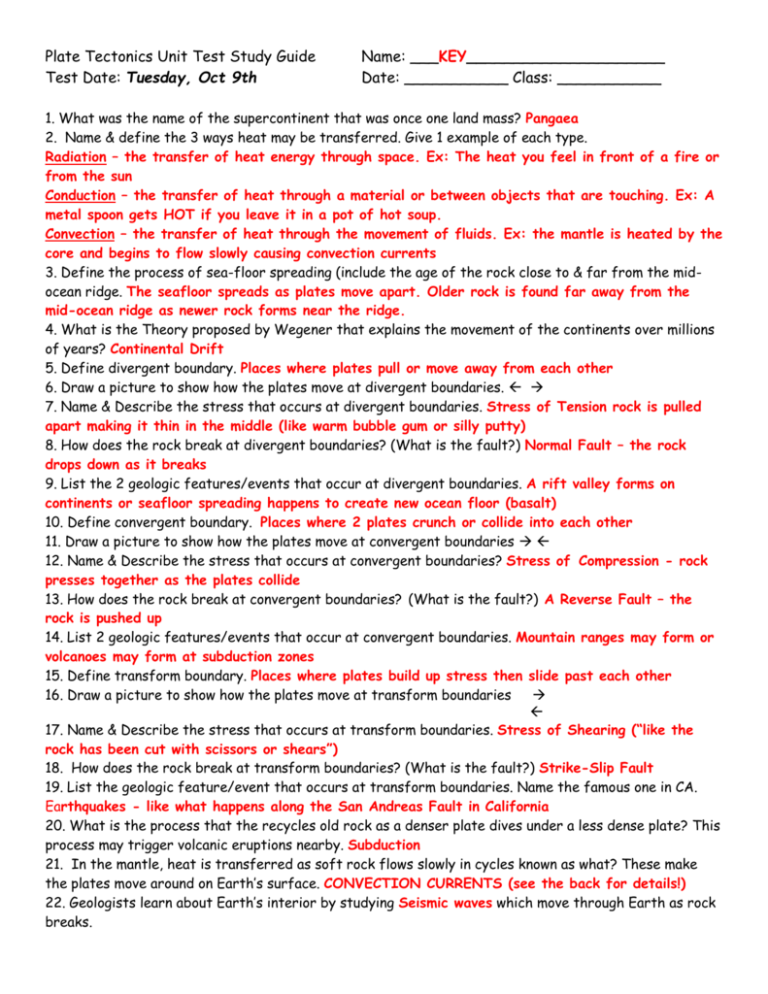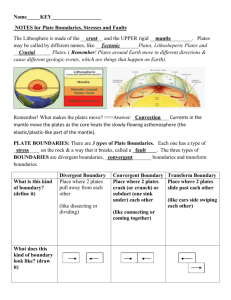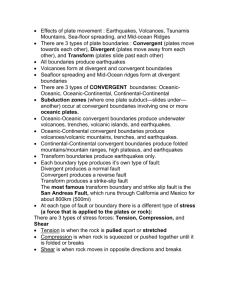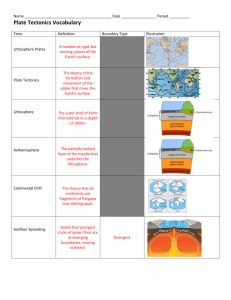Plate Tectonics Unit Test Study Guide
advertisement

Plate Tectonics Unit Test Study Guide Test Date: Tuesday, Oct 9th Name: ___KEY_____________________ Date: ___________ Class: ___________ 1. What was the name of the supercontinent that was once one land mass? Pangaea 2. Name & define the 3 ways heat may be transferred. Give 1 example of each type. Radiation – the transfer of heat energy through space. Ex: The heat you feel in front of a fire or from the sun Conduction – the transfer of heat through a material or between objects that are touching. Ex: A metal spoon gets HOT if you leave it in a pot of hot soup. Convection – the transfer of heat through the movement of fluids. Ex: the mantle is heated by the core and begins to flow slowly causing convection currents 3. Define the process of sea-floor spreading (include the age of the rock close to & far from the midocean ridge. The seafloor spreads as plates move apart. Older rock is found far away from the mid-ocean ridge as newer rock forms near the ridge. 4. What is the Theory proposed by Wegener that explains the movement of the continents over millions of years? Continental Drift 5. Define divergent boundary. Places where plates pull or move away from each other 6. Draw a picture to show how the plates move at divergent boundaries. 7. Name & Describe the stress that occurs at divergent boundaries. Stress of Tension rock is pulled apart making it thin in the middle (like warm bubble gum or silly putty) 8. How does the rock break at divergent boundaries? (What is the fault?) Normal Fault – the rock drops down as it breaks 9. List the 2 geologic features/events that occur at divergent boundaries. A rift valley forms on continents or seafloor spreading happens to create new ocean floor (basalt) 10. Define convergent boundary. Places where 2 plates crunch or collide into each other 11. Draw a picture to show how the plates move at convergent boundaries 12. Name & Describe the stress that occurs at convergent boundaries? Stress of Compression - rock presses together as the plates collide 13. How does the rock break at convergent boundaries? (What is the fault?) A Reverse Fault – the rock is pushed up 14. List 2 geologic features/events that occur at convergent boundaries. Mountain ranges may form or volcanoes may form at subduction zones 15. Define transform boundary. Places where plates build up stress then slide past each other 16. Draw a picture to show how the plates move at transform boundaries 17. Name & Describe the stress that occurs at transform boundaries. Stress of Shearing (“like the rock has been cut with scissors or shears”) 18. How does the rock break at transform boundaries? (What is the fault?) Strike-Slip Fault 19. List the geologic feature/event that occurs at transform boundaries. Name the famous one in CA. Earthquakes - like what happens along the San Andreas Fault in California 20. What is the process that the recycles old rock as a denser plate dives under a less dense plate? This process may trigger volcanic eruptions nearby. Subduction 21. In the mantle, heat is transferred as soft rock flows slowly in cycles known as what? These make the plates move around on Earth’s surface. CONVECTION CURRENTS (see the back for details!) 22. Geologists learn about Earth’s interior by studying Seismic waves which move through Earth as rock breaks.








